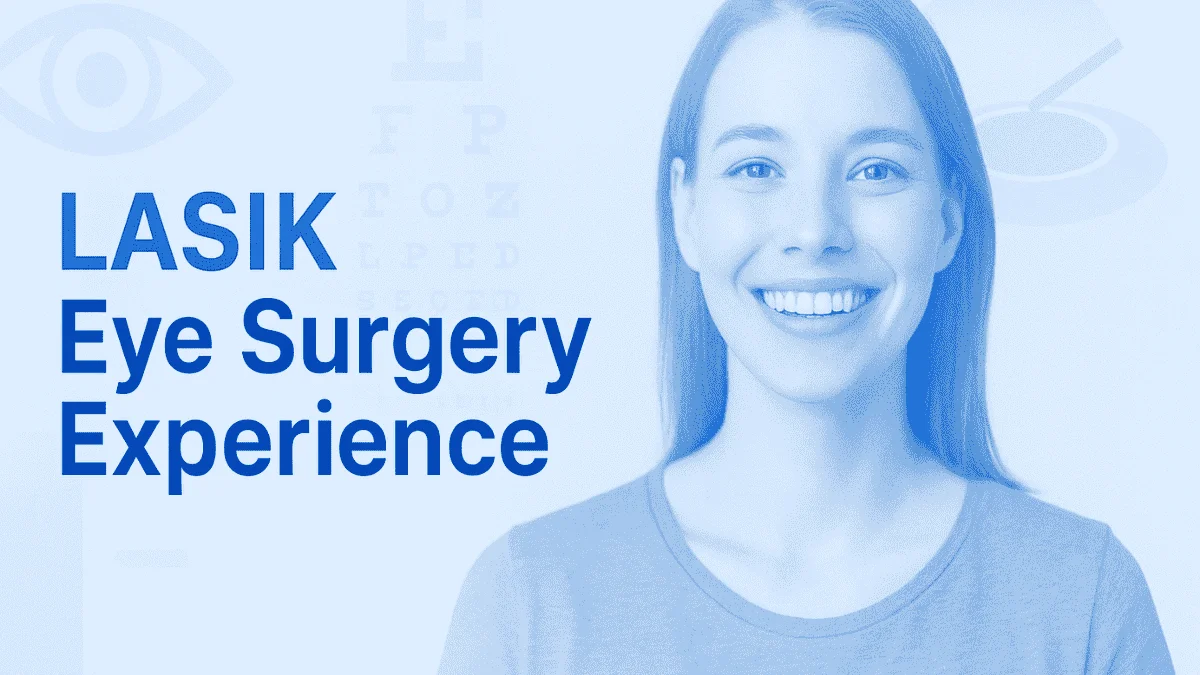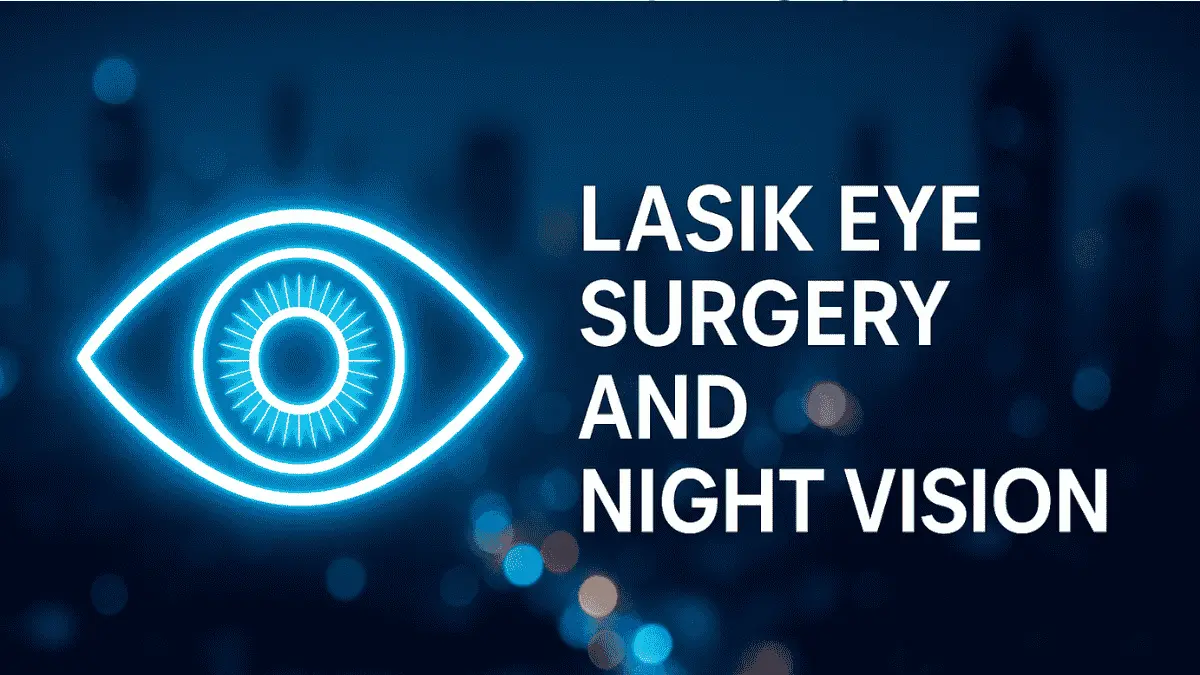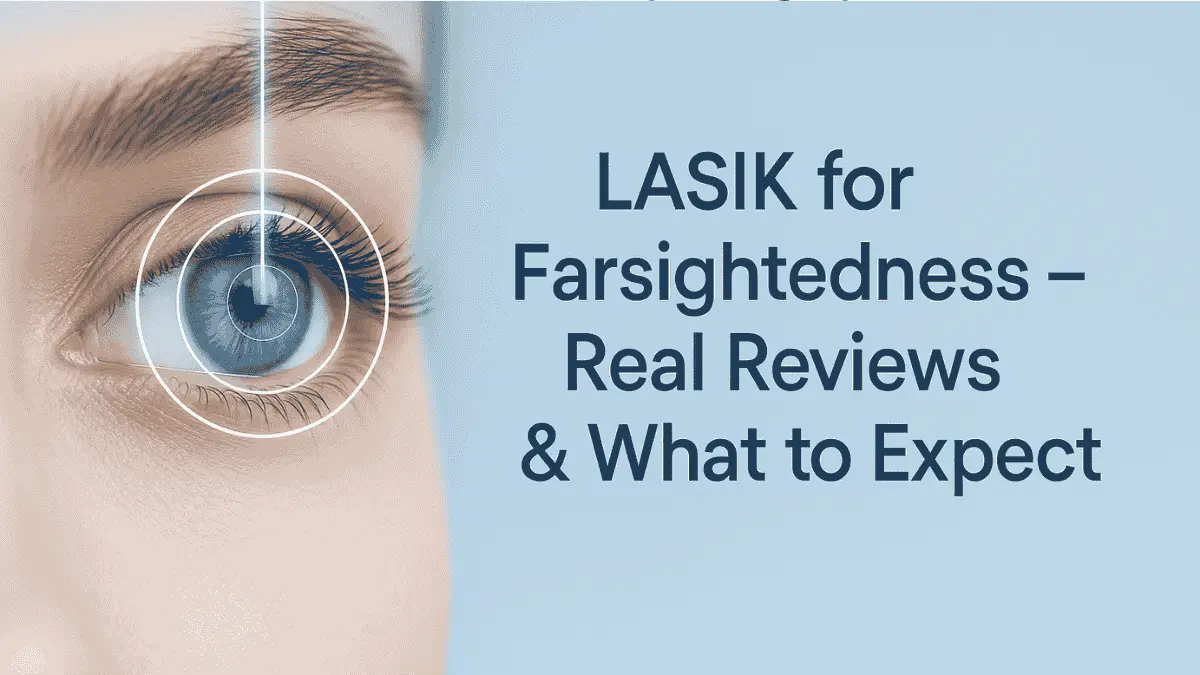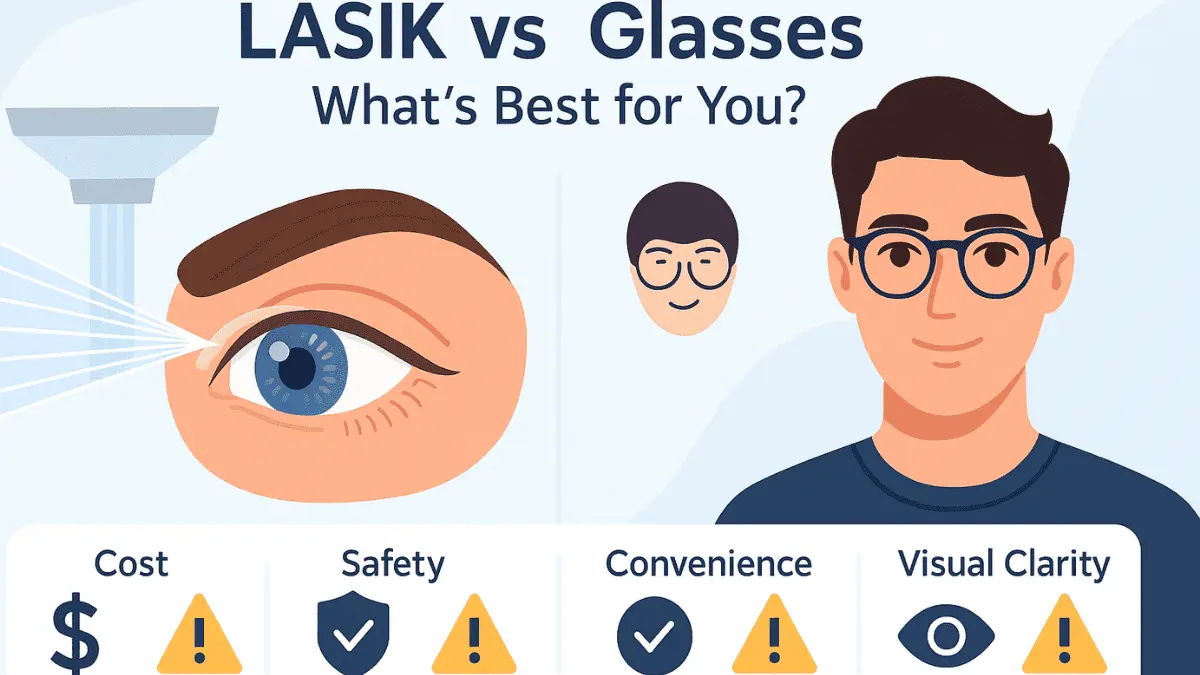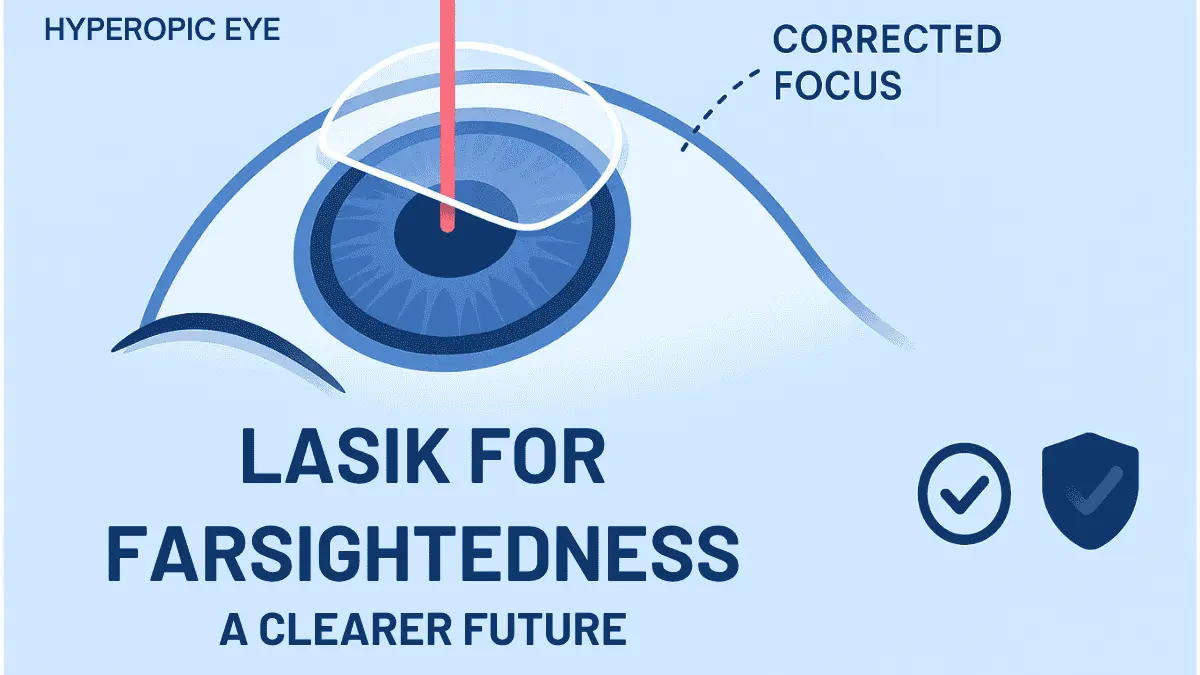
Tired of squinting at things up close? Does reading a menu or a text message feel like a struggle, often causing difficulty reading? You might be dealing with farsightedness, a common vision issue that affects your ability to see nearby objects clearly. Many people like you look for ways to see clearly without always reaching for reading glasses or contact lenses. Good news – LASIK for farsightedness could be an effective treatment option for you. This guide will walk you through everything about this popular laser eye surgery, so you understand how vision LASIK can help with farsightedness hyperopia.
Table of Contents
What Is Farsightedness (Hyperopia)?
Farsightedness, known medically as hyperopia, makes close-up objects appear blurry, while distance vision might remain clear. This refractive error can make tasks like reading, using a computer, or focusing on nearby objects quite challenging. Hyperopia occurs because the eye focuses images behind the retina, instead of directly on it. This focusing issue can stem from the eyeball being too short (axial hyperopia) or the cornea, the eye’s clear front surface, having too little curvature (refractive hyperopia).
Common symptoms often include eyestrain, headaches after prolonged close work, and a general difficulty focusing on near tasks. Some individuals may squint to try and see nearby objects more clearly, which can lead to further discomfort. According to the National Eye Institute, hyperopia can affect both children and adults, and its prevalence often increases with age, sometimes linked to the natural aging process.
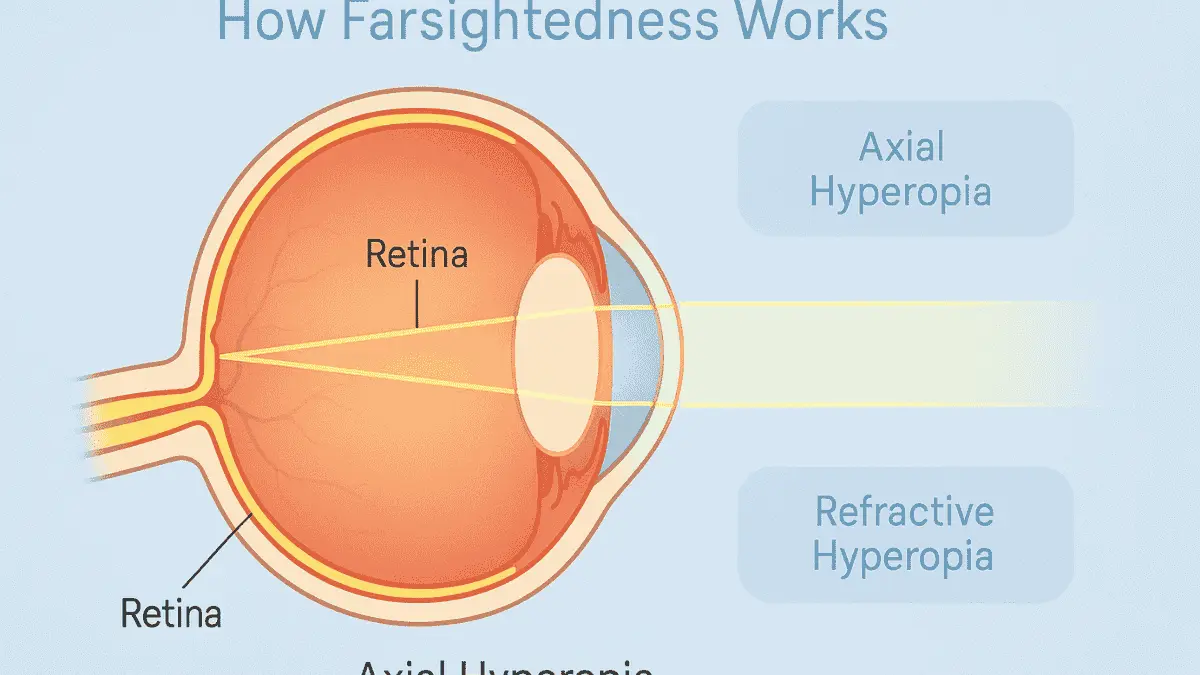
Diagnosing hyperopia typically involves a comprehensive eye exam performed by an eye care professional. During this exam, various tests are conducted to assess how your eyes focus light and to determine the exact nature of your vision problems. It’s important to distinguish hyperopia from other vision conditions such as nearsightedness (myopia), where distant objects are blurry, or astigmatism, where vision is distorted at all distances due to an irregularly shaped cornea or lens. Understanding your specific eye conditions is the first step toward finding the right correction options.
Related Article
What is Farsightedness?How LASIK Works for Farsightedness
So, how can laser vision correction help with this particular vision problem? LASIK surgery, a type of refractive surgery, reshapes your cornea. For farsightedness, the objective of the LASIK procedure is to make the cornea steeper, enhancing its focusing power. This adjustment changes how light rays enter your eye, allowing them to focus light correctly on the retina for improved clarity of nearby objects.
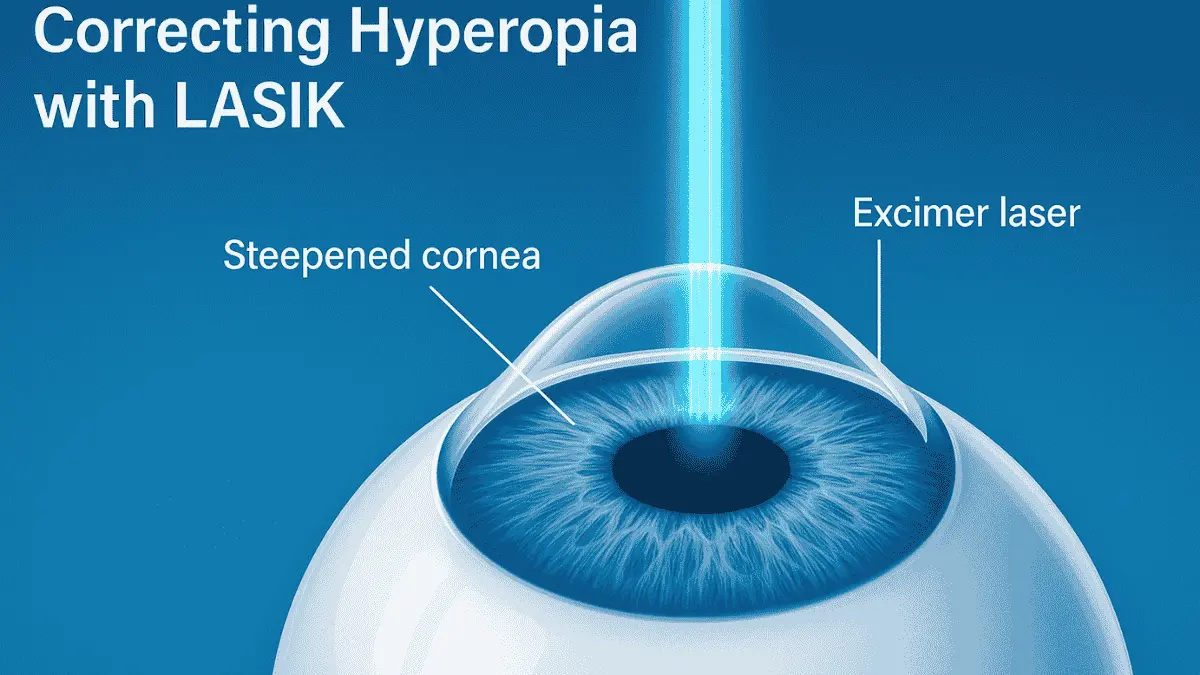
An advanced tool called an excimer laser performs the precise corneal reshaping required to correct vision. This laser uses a cool ultraviolet light beam to ablate, or remove, microscopic amounts of corneal tissue with incredible accuracy. This careful sculpting during the laser surgery effectively changes the cornea’s focusing power. The way LASIK corrects hyperopia is by steepening the central cornea, which is fundamentally different from how it treats myopia, where the cornea is flattened to correct distance vision issues. Some advanced LASIK treatments may utilize wavefront technology for a more customized laser vision correction, mapping the unique imperfections of your eye for a highly precise lasik treatment.
Who Is a Good Candidate for LASIK for farsightedness?
Not everyone with farsightedness is a perfect match for LASIK eye surgery. Several factors determine if you are a good candidate for hyperopia treatment with LASIK. Your eye doctor will conduct a comprehensive eye assessment, looking at your specific prescription; generally, LASIK can correct farsightedness hyperopia up to around +4.00 diopters, sometimes more depending on the specific laser technology used and your individual eye characteristics. It’s essential that your vision problems are stable, meaning your prescription hasn’t significantly changed for at least one year before you undergo LASIK.
Age is another consideration for this eye surgery. You typically need to be at least 18 years old for laser eye surgery. While there isn’t a strict upper age limit for vision LASIK, older individuals might experience other age-related eye conditions, such as presbyopia (the natural aging process that causes difficulty with reading vision) or cataracts. Presbyopia can complicate the outcomes of LASIK for farsightedness, as LASIK primarily corrects distance or intermediate vision affected by hyperopia, but not the separate mechanism of presbyopia. Some patients might opt for a monovision correction, where one eye is corrected for distance and the other for near, though this isn’t suitable for everyone.
Sufficient corneal thickness is another critical requirement for LASIK, as the procedure involves creating a lasik flap and removing a small amount of tissue. Your general health and health history are also important; certain systemic conditions, such as uncontrolled diabetes or autoimmune diseases like Sjogren’s syndrome or rheumatoid arthritis, might increase risks or affect healing. Eye conditions like severe dry eye syndrome, advanced glaucoma, keratoconus (a progressive thinning of the cornea), or active eye infections can also prevent you from being a good candidate. A thorough eye exam and discussion with your refractive surgery specialist will determine your suitability and explore if other treatment options are more appropriate for your eye care needs.
The LASIK Procedure for Hyperopia
Knowing what to expect can make the LASIK eye process smoother and less stressful. Before the laser eye surgery, you’ll have a detailed comprehensive eye exam. This pre-operative assessment includes precise measurements of your refractive error, corneal shape (topography), and corneal thickness (pachymetry), and a thorough check of your overall eye health. You’ll need to stop wearing contact lenses for a specific period before this exam and the surgery itself—typically one to two weeks for soft lenses and longer for hard or gas permeable lenses—as contact lens wear can temporarily alter your cornea’s shape, affecting measurement accuracy.
On the day of your hyperopia LASIK, which is a day surgery, you will be awake during the procedure. Numbing eye drops are administered to ensure you don’t feel pain during the surgery lasik; you might feel slight pressure. The surgeon first creates a thin, hinged flap in your cornea. This lasik flap can be made using a highly precise mechanical instrument called a microkeratome or, more commonly today, with a femtosecond laser for an all-laser LASIK procedure. The femtosecond laser offers enhanced precision in flap creation. This flap is then gently lifted to expose the underlying corneal tissue (stroma).
Related Article
How Effective is LASIK for Farsightedness?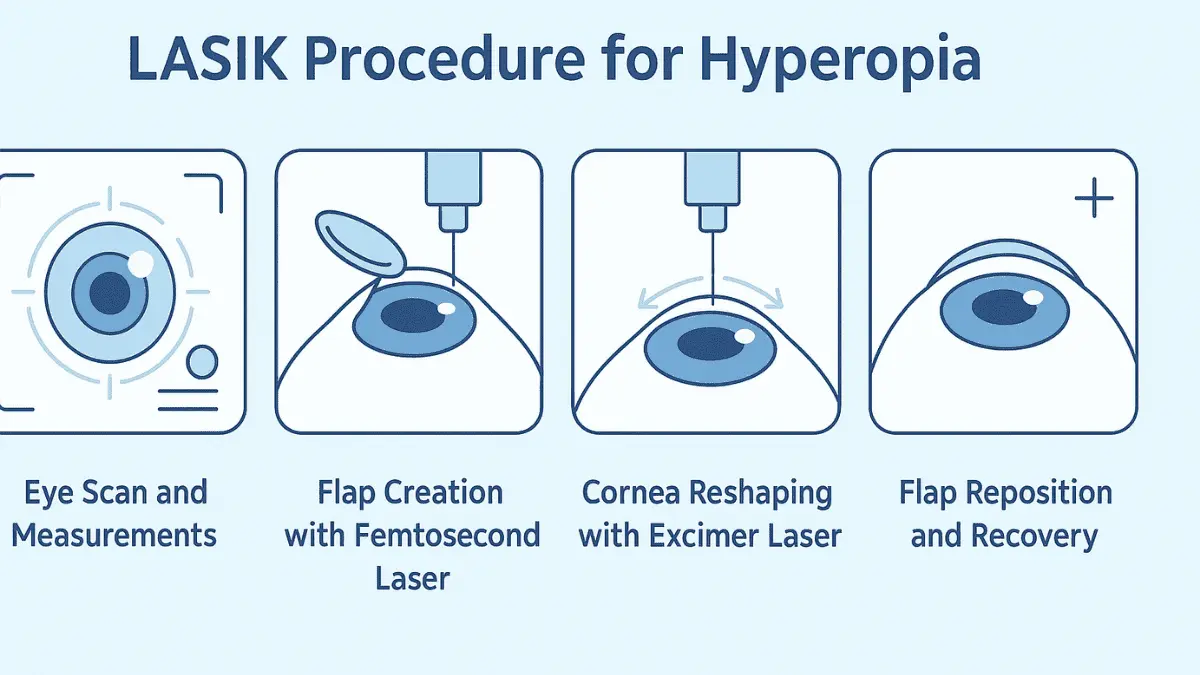
Next, the excimer laser, guided by a sophisticated computer system mapping your eye’s unique characteristics, reshapes the corneal tissue. To correct farsightedness, the laser removes tissue in a circular pattern in the periphery of the cornea, which effectively steepens its central curvature. This part of the surgery procedure usually takes less than a minute per eye. After the reshaping is complete, the corneal flap is carefully repositioned, where it adheres naturally without stitches and begins to heal almost immediately. The entire LASIK procedure typically takes about 10–15 minutes per eye.
During the initial recovery period after LASIK, you might experience some mild discomfort, such as itching, burning, or a feeling like there’s something in your eye, for a few hours. Your vision will likely be somewhat hazy or experience blurry vision immediately after the lasik surgery, but it should start to improve significantly by the next day, with many patients experiencing a noticeable difference. You’ll be prescribed antibiotic and anti-inflammatory eye drops to prevent infection and reduce inflammation. Following your surgeon’s post-operative care instructions, including attending follow-up appointments, is very important for optimal healing and a successful outcome in correcting vision problems. This care will help manage any temporary light sensitivity or other common post-surgery symptoms.
Benefits of LASIK for Farsightedness
The most exciting benefit of LASIK surgery is often the significantly improved uncorrected visual acuity, particularly for nearby objects. Imagine waking up and seeing the alarm clock clearly, or reading a book or your phone without instinctively reaching for your reading glasses. Many hyperopic patients experience a dramatic reduction in their dependency on glasses or contact lens use, leading to a profound lifestyle improvement. This newfound freedom can be especially valuable if you enjoy sports, swimming, or other activities where corrective eyewear can be cumbersome or impractical.
While the primary goal is long-term vision correction, it is important to have realistic expectations discussed with your surgery team. Most people achieve excellent vision after hyperopia LASIK, often 20/20 or better for distance, with substantial improvement in near vision. This enhanced freedom from corrective lenses frequently leads to a greater sense of confidence and spontaneity in daily life. Additionally, over time, you might save money that would have otherwise been spent on prescription updates for glasses, new contact lenses, and various cleaning solutions, making it a sound investment in your eye care.
The quick recovery associated with the LASIK procedure is another significant advantage. Most patients can return to many of their normal activities, including work, within a day or two, though some restrictions, like avoiding rubbing the eyes or strenuous activities, will apply for a short period. The precision of the femtosecond laser and excimer laser technology contributes to these positive outcomes, helping to correct vision problems effectively.
Risks and Side Effects
Like any surgical procedure, LASIK for farsightedness comes with potential risks and side effects, though serious complications are rare. Common temporary issues include dry eyes, which can be managed with lubricating eye drops (artificial tears) and typically improve as the eyes heal over weeks or months. Some patients experience glare, halos around lights, or starbursts, especially at night or in low-light conditions. These symptoms usually diminish over a few weeks or months as your eyes adapt and heal post-surgery.
For patients undergoing LASIK to correct farsightedness, there’s sometimes a slightly higher chance of initial overcorrection, meaning you might become temporarily nearsighted. Regression, where the eye slowly drifts back towards its original prescription, can also occur, though this is less common with modern LASIK techniques. Undercorrection is another possibility. Both may necessitate an enhancement procedure if the vision imbalance is significant.
More serious complications, such as infection, inflammation, or issues with the lasik flap (like displacement or epithelial ingrowth), are rare but possible. Adhering strictly to post-operative care instructions is crucial to minimize these risks. The FDA provides a good overview of what to consider before undergoing any laser eye surgery. Discussing all potential risks and side effects thoroughly with your surgeon will help you make an informed decision about this treatment option.
Success Rates and Long-Term Results
The LASIK success rate for hyperopia is generally very high, with many studies reporting excellent visual outcomes and high patient satisfaction. The precise results can depend on several factors, including the initial degree of your farsightedness, your age, corneal characteristics, and the specific laser technology used for the LASIK procedure. For lower to moderate levels of farsightedness, the outcomes are typically more predictable and stable, offering a significant improvement in how patients see nearby objects.
Long-term LASIK results demonstrate that many people maintain their improved vision for many years. However, it is important to remember that LASIK eye surgery does not stop the natural aging process of the eyes. Presbyopia, the age-related difficulty with near vision (often leading to the need for reading glasses) that typically begins to affect people in their 40s, will still occur regardless of whether you’ve had LASIK to correct farsightedness. LASIK corrects existing refractive error but doesn’t prevent future age-related changes. Some individuals who undergo LASIK for hyperopia may still need reading glasses for close tasks as they enter their presbyopic years.
Sometimes, an enhancement or retreatment procedure might be considered later on if there is significant regression or if the initial vision correction was not optimal. This is not common for most farsighted patients who achieve a good initial correction from their laser eye surgery. Modern advancements in laser vision correction technology, including sophisticated eye-tracking systems and customized ablation profiles from the excimer laser, have significantly improved the predictability and stability of LASIK outcomes for farsighted patients. Careful patient selection by an experienced surgery team, based on a comprehensive eye exam and detailed health history, also plays a vital part in achieving great long-term results and minimizing the chance of vision imbalance.
LASIK vs PRK for Farsightedness
When looking at laser eye surgery options for farsightedness, you might also hear about photorefractive keratectomy (PRK). Both LASIK (Laser-Assisted In Situ Keratomileusis) and PRK are types of refractive surgery that use an excimer laser to reshape the cornea and correct vision problems. The main difference between these treatment options lies in how the surgeon accesses the underlying corneal tissue to perform the laser surgery.
With LASIK, a thin corneal flap is created using a microkeratome or a femtosecond laser. This flap is lifted, the cornea is reshaped, and then the flap is repositioned. With PRK, the thin outer layer of the cornea (the epithelium) is gently removed completely before the laser treatment is applied; this epithelial layer then grows back naturally over a few days post-surgery. Here’s a quick comparison of these two common types of vision correction:
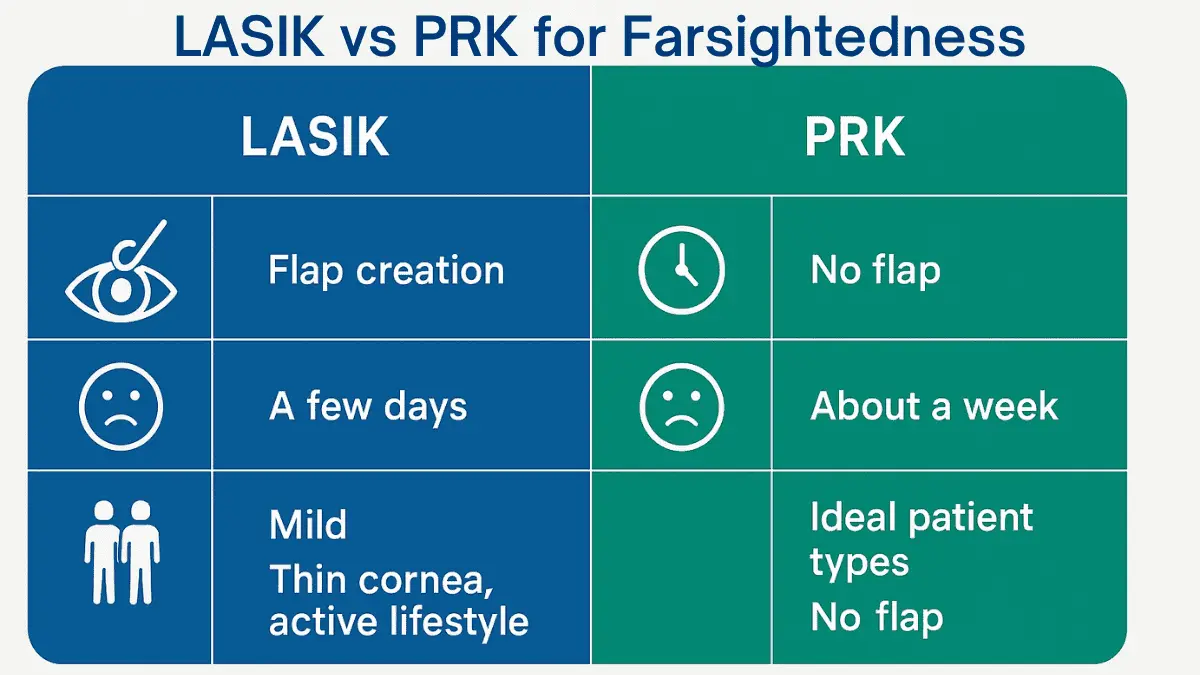
| Feature | LASIK for Hyperopia | PRK for Hyperopia |
|---|---|---|
| Corneal Flap | Yes, the lasik flap is created and repositioned. | No flap; epithelium is removed and regenerates. |
| Initial Recovery | Faster visual recovery, often within 1-2 days. | Slower visual recovery; more discomfort initially (typically 3-5 days). |
| Discomfort | Minimal, usually lasting a few hours. | Moderate, can last for a few days, managed with medication. |
| Dry Eyes | Can be more common or pronounced initially. | Potentially less risk of chronic dry eyes for some patients. |
| Long-Term Results | Very good and stable vision correction. | Very good and stable; similar long-term efficacy to LASIK. |
| Best For | Most eligible hyperopic patients seeking quick recovery. | Patients with thinner corneas, certain lifestyle factors (e.g., contact sports), specific occupations, or significant dry eye concerns. |
Both LASIK and photorefractive keratectomy offer excellent effectiveness to correct farsightedness and other refractive error issues. Your surgeon will recommend the best alternative treatment option based on your specific eye health, corneal thickness, results from your eye exam, lifestyle, and personal preferences. The recovery time for farsighted patients after PRK is generally longer and involves more initial discomfort than LASIK. However, for some individuals, PRK is the safer or more suitable choice for achieving permanent vision correction. Other vision correction options, such as refractive lens exchange (RLE) involving a lens implant, or corneal inlay procedures, might be considered for specific cases of hyperopia, especially in older patients or those with very high prescriptions who may not be a good candidate for laser vision procedures.
Cost of LASIK for Hyperopia in the USA
The cost of LASIK eye surgery can vary significantly across the United States. On average, LASIK for hyperopia can range from $2,000 to $4,000 per eye. Several factors influence this price. The surgeon’s experience and reputation, the specific type of technology used (such as all-laser LASIK with a femtosecond laser for flap creation, or advanced custom wavefront-guided excimer laser platforms), and the geographic location of the clinic all play a part in determining the final cost of this treatment option.
You might observe regional or state-specific variations in cost. For instance, prices in major metropolitan areas could be higher than in smaller towns due to differences in overhead and market demand. It is important to know that most health insurance plans consider LASIK an elective procedure, meaning they usually do not cover the cost. However, some vision plans might offer a percentage discount on refractive surgery. Many clinics offer financing options or payment plans to help make the laser surgery more affordable. Additionally, some people use their Flexible Spending Accounts (FSAs) or Health Savings Accounts (HSAs) to pay for LASIK with pre-tax dollars, which can represent a considerable saving.
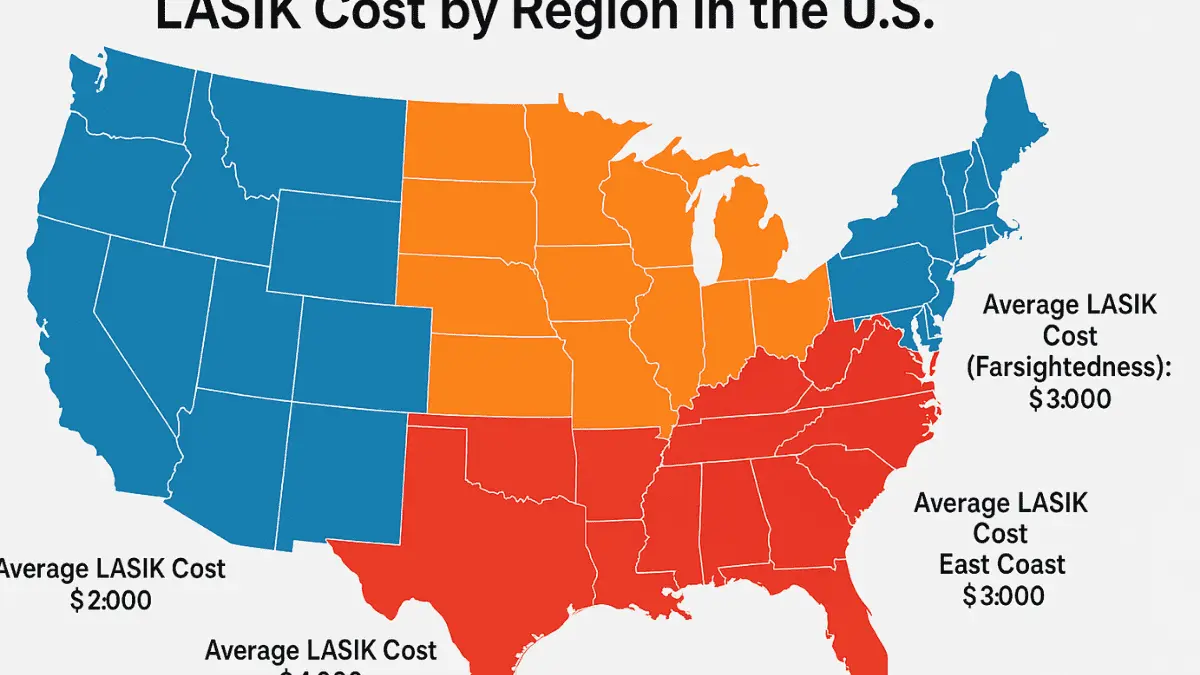
When you receive a price quote for your LASIK eye surgery, make sure to ask what is included in the fee. A comprehensive package for this laser eye procedure should typically cover the initial comprehensive eye exam, the surgery itself, all post-operative appointments for a specified period, and any necessary medications like eye drops or enhancements, should they be needed. It’s wise not to choose a provider solely based on the lowest price; the skill of your surgery team and the quality of the technology are crucial for achieving good results and optimal eye care with your vision correction surgery. Remember, investing in LASIK is an investment in your quality of life and can reduce long-term expenses associated with wearing glasses or contact lenses.
Alternative Treatment Options to LASIK
While LASIK is a popular and effective treatment for farsightedness, it’s not the only solution available. Understanding alternative treatment options can help you make a fully informed decision. Non-surgical options are the most common approach for managing hyperopia.
These include eyeglasses, which are a simple and safe way to correct vision problems. Contact lenses are another common choice, offering a wider field of view and more convenience for active lifestyles than wearing glasses. However, both require ongoing care and expense, and some find them inconvenient or uncomfortable.
For those seeking a more permanent solution beyond LASIK or PRK, other surgical procedures might be considered. Refractive Lens Exchange (RLE) is one such alternative treatment. This procedure is very similar to cataract surgery; the eye’s natural lens is removed and replaced with an artificial intraocular lens implant (IOL) that is calculated to correct the refractive error. RLE can be particularly effective for older patients with high hyperopia or early signs of cataracts. Different types of lens implants are available, including multifocal or accommodating lenses, which can also help with presbyopia, the age-related difficulty reading.
Another less common surgical option might be a corneal inlay. This involves surgically placing a small, thin optical device into the cornea of one eye to improve near vision. These are generally considered more for presbyopia correction but can sometimes be relevant in discussions about correcting farsightedness, especially if near vision is a primary concern. Each of these correction options has its own set of benefits, risks, and candidacy criteria. A thorough discussion with your eye care professional about all available vision correction options, including non-surgical options and different types of eye surgery, will help determine the best path for your individual needs and eye health. They will consider your general health, lifestyle, and the specifics of your farsightedness hyperopia.
Related Article
SMILE Laser Eye Surgery OverviewRelated Article
What to Know About PRK SurgeryConclusion
Deciding on LASIK for farsightedness is a significant step, but it can truly change how you see the world and interact with nearby objects, potentially eliminating the daily need for reading glasses. Understanding hyperopia, how LASIK surgery works to correct it, and what to expect from the lasik procedure can help you feel more confident in your choice. Remember, while the benefits like clearer vision and less reliance on corrective eyewear are fantastic, it’s also vital to consider the eligibility criteria, potential risks, and the recovery process specific to farsighted LASIK patients who undergo LASIK.
This guide aimed to give you a solid foundation about this vision correction treatment option. However, the most important conversation is the one you will have with a qualified and experienced eye surgeon who specializes in refractive surgery. They can fully assess your eyes through a comprehensive eye exam, review your health history, explain your vision correction options, and help you determine if hyperopia LASIK is the right path for you to correct farsightedness. The surgery team will also explain everything clearly, address concerns about potential blurred vision post-op or light sensitivity, and answer all your questions about the eye surgery. Many people find that careful research and a thorough consultation lead to a satisfying outcome and improved quality of life. Take the time to find a trusted professional for your eye care needs to explore how to correct vision effectively.
Now is a great time to take action if you’re tired of the limitations imposed by farsightedness hyperopia. Consider reaching out to a reputable LASIK center. You can ask them about how to check your candidacy for LASIK for farsightedness or if alternative treatment options like photorefractive keratectomy or lens implants might be better. Or, go ahead and book a consultation to discuss your specific needs, learn more about the surgery procedure, and get personalized advice about your options include for laser vision correction from a comprehensive eye care provider.
LASIK corrects farsightedness by reshaping the cornea to make it steeper. This helps light rays focus properly on the retina instead of behind it, improving near vision.
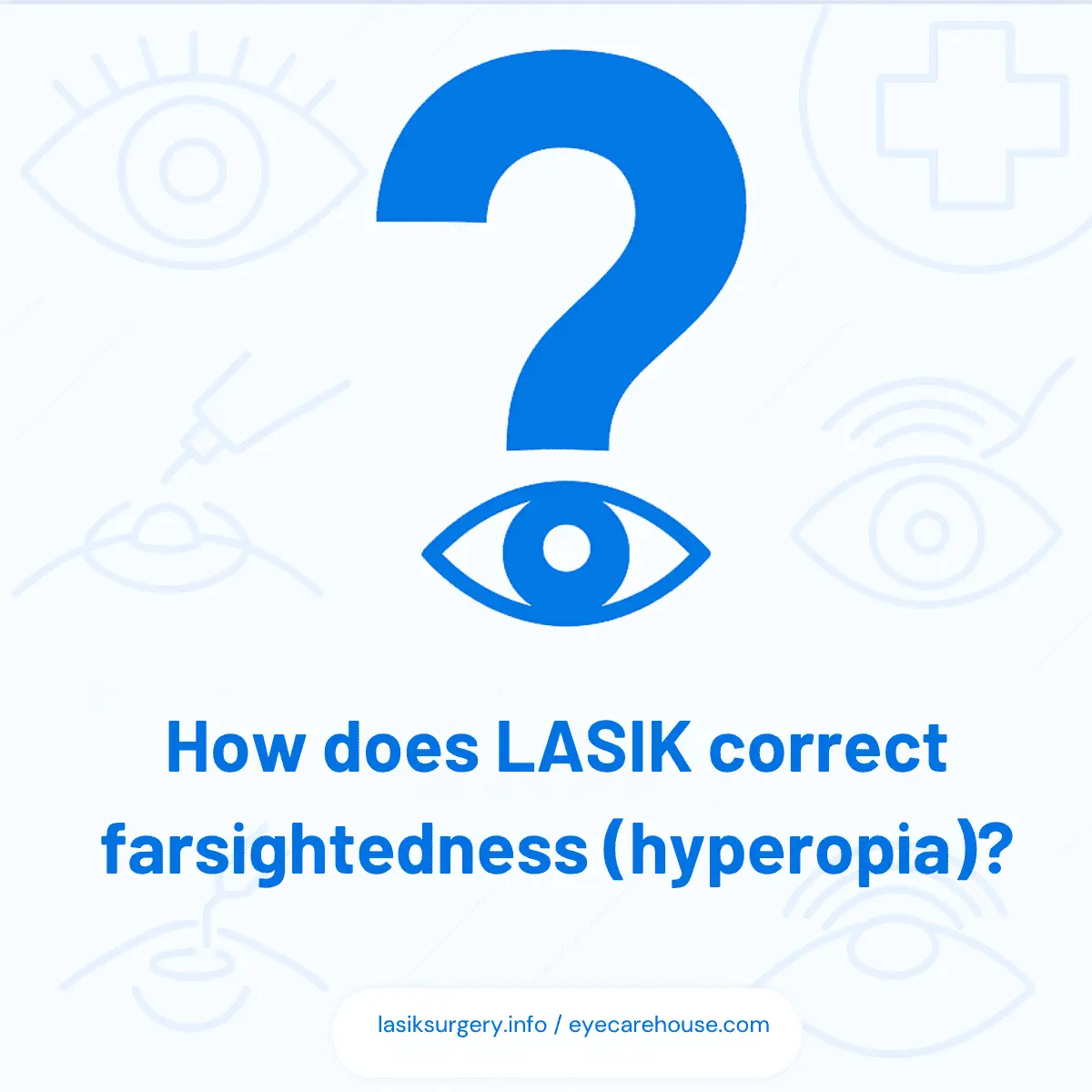
The ideal age for LASIK is 18 and older, once your eye prescription has stabilized for at least a year. There is no strict upper limit, but age-related conditions like presbyopia may affect outcomes.
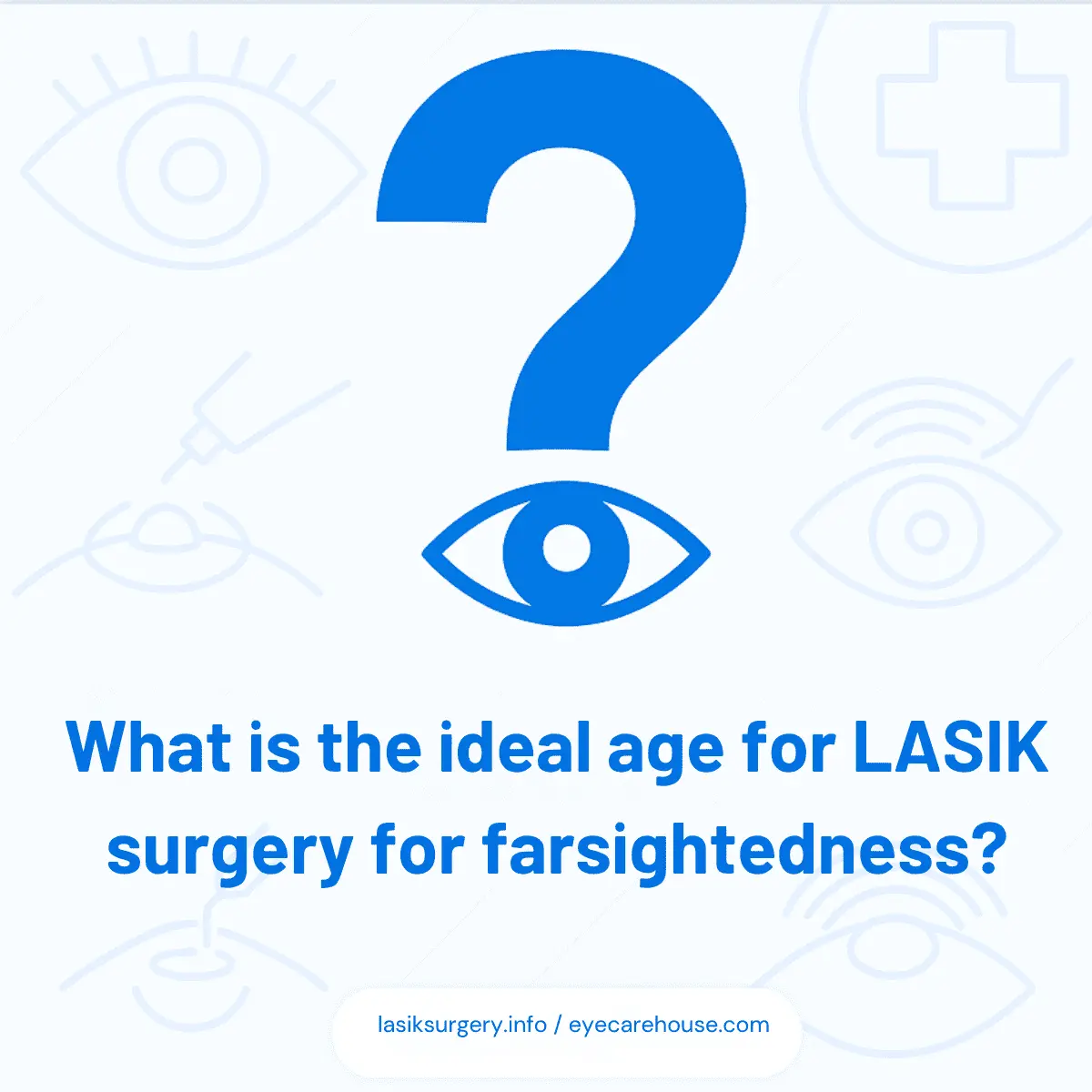
While LASIK can significantly reduce dependence on reading glasses for hyperopia, it may not fully eliminate them, especially in older patients affected by presbyopia.

Some risks include dry eyes, glare, halos, temporary overcorrection, or regression. Serious complications like infection or flap issues are rare with modern LASIK methods.
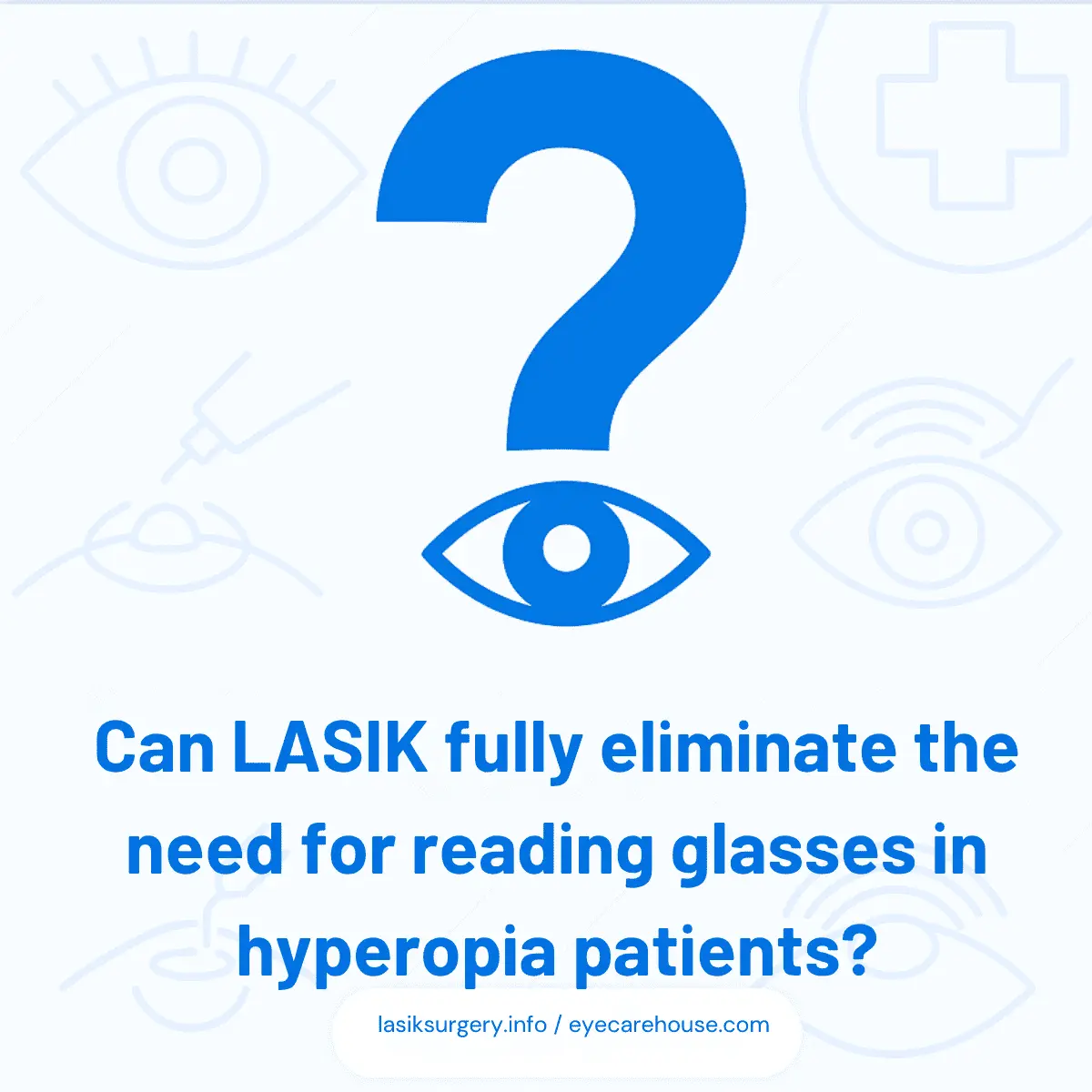
Most people notice vision improvement within 24-48 hours. Full healing may take a few weeks, though most return to normal activities within days.
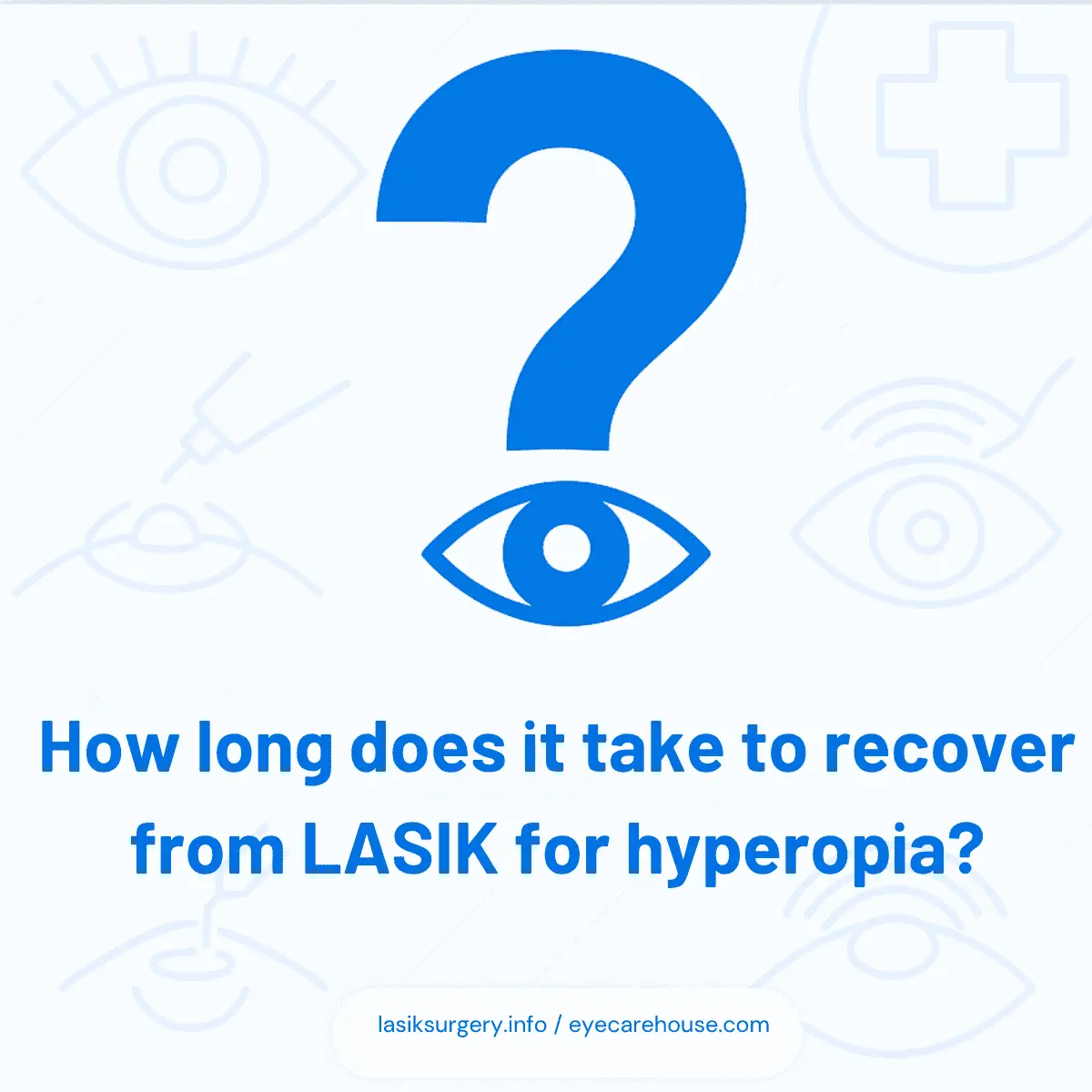
Both procedures are effective. LASIK offers quicker recovery, while PRK is better for patients with thin corneas or high dry eye risk. Your eye surgeon will help decide.
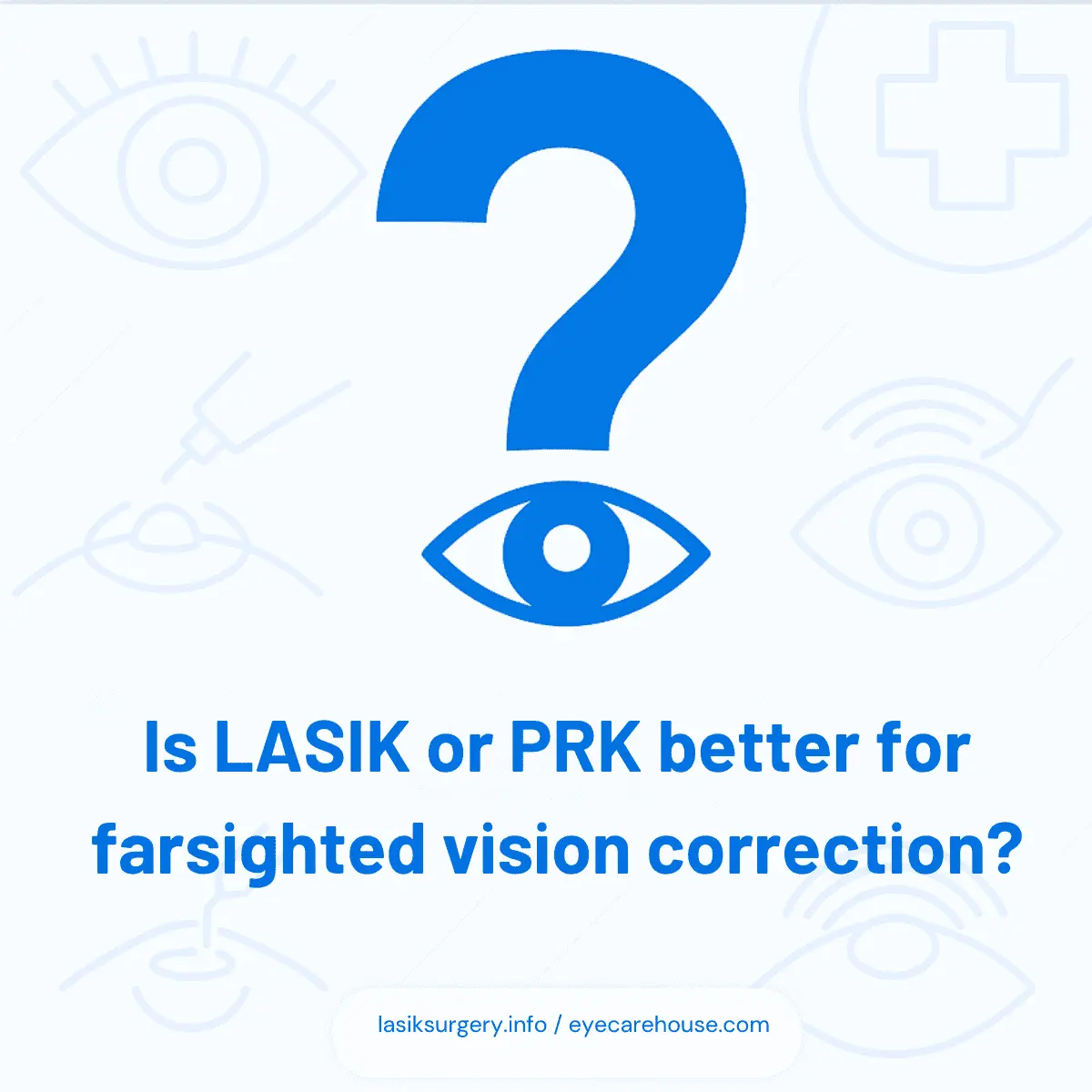
The cost typically ranges from $2,000 to $4,000 per eye. Prices vary based on location, technology used, and surgeon expertise. Insurance usually doesn’t cover LASIK.
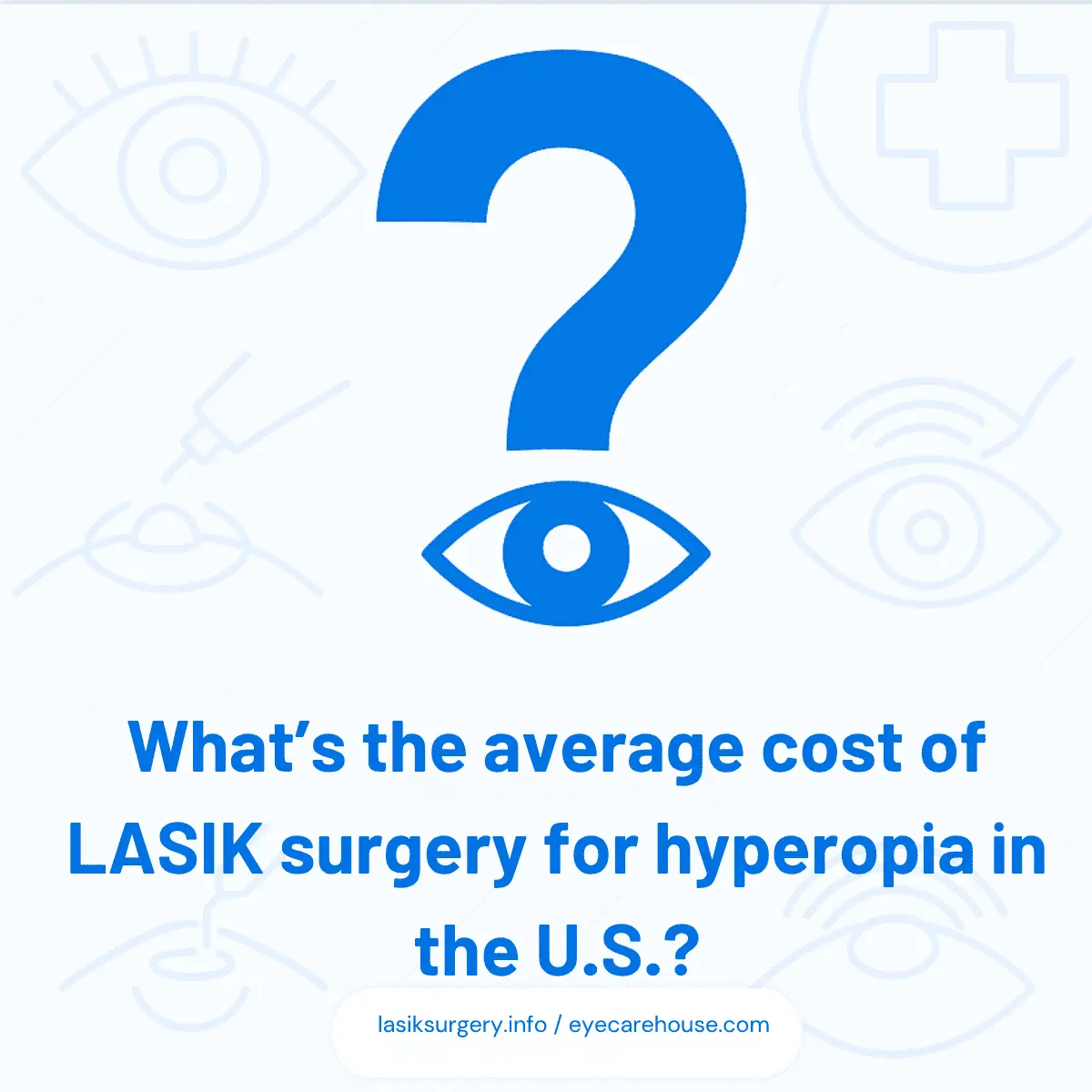
People with unstable prescriptions, thin corneas, dry eye syndrome, or autoimmune conditions may not qualify for LASIK. A detailed eye exam is essential.
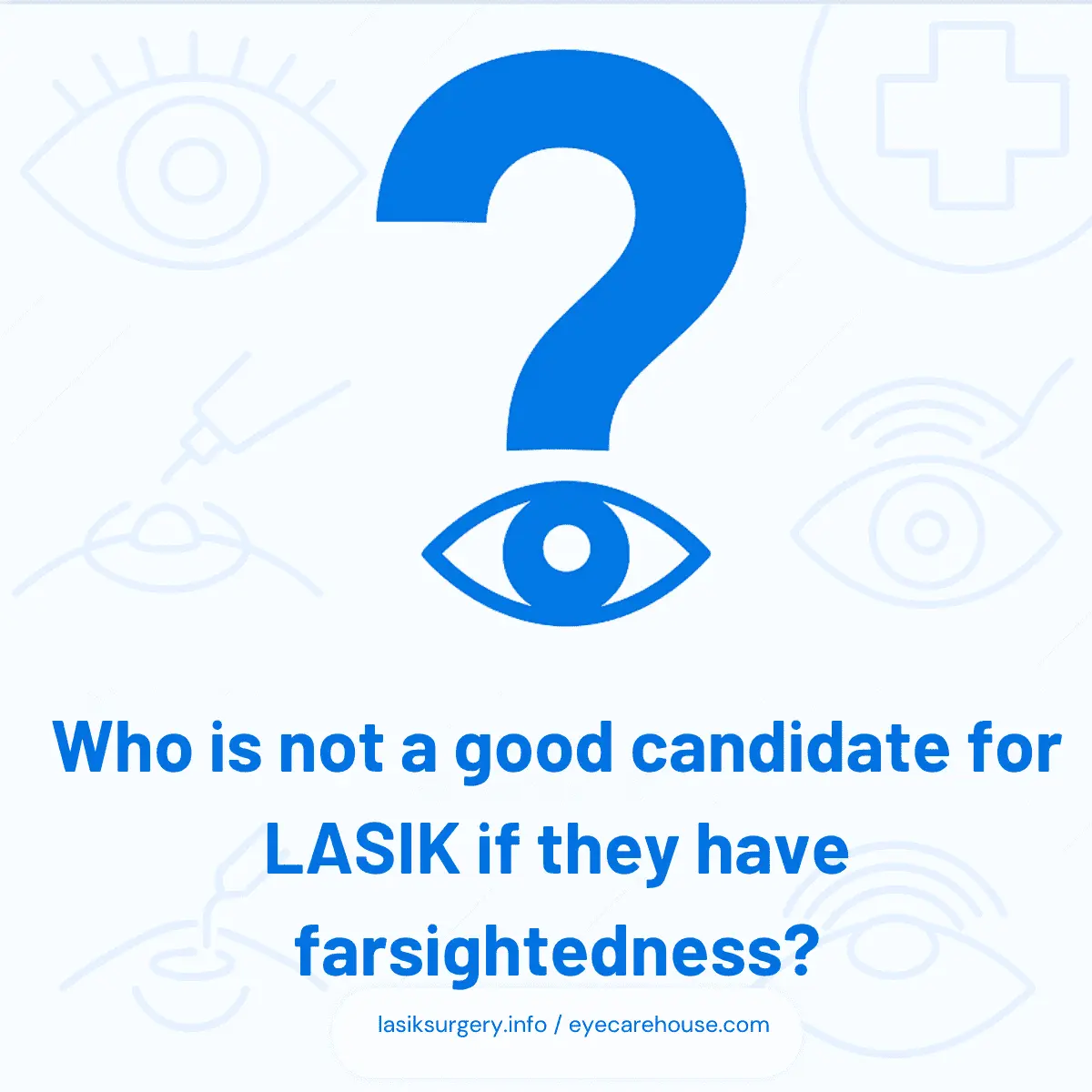
LASIK provides long-lasting results, but some patients may experience regression over time. Enhancements can sometimes be done if needed.
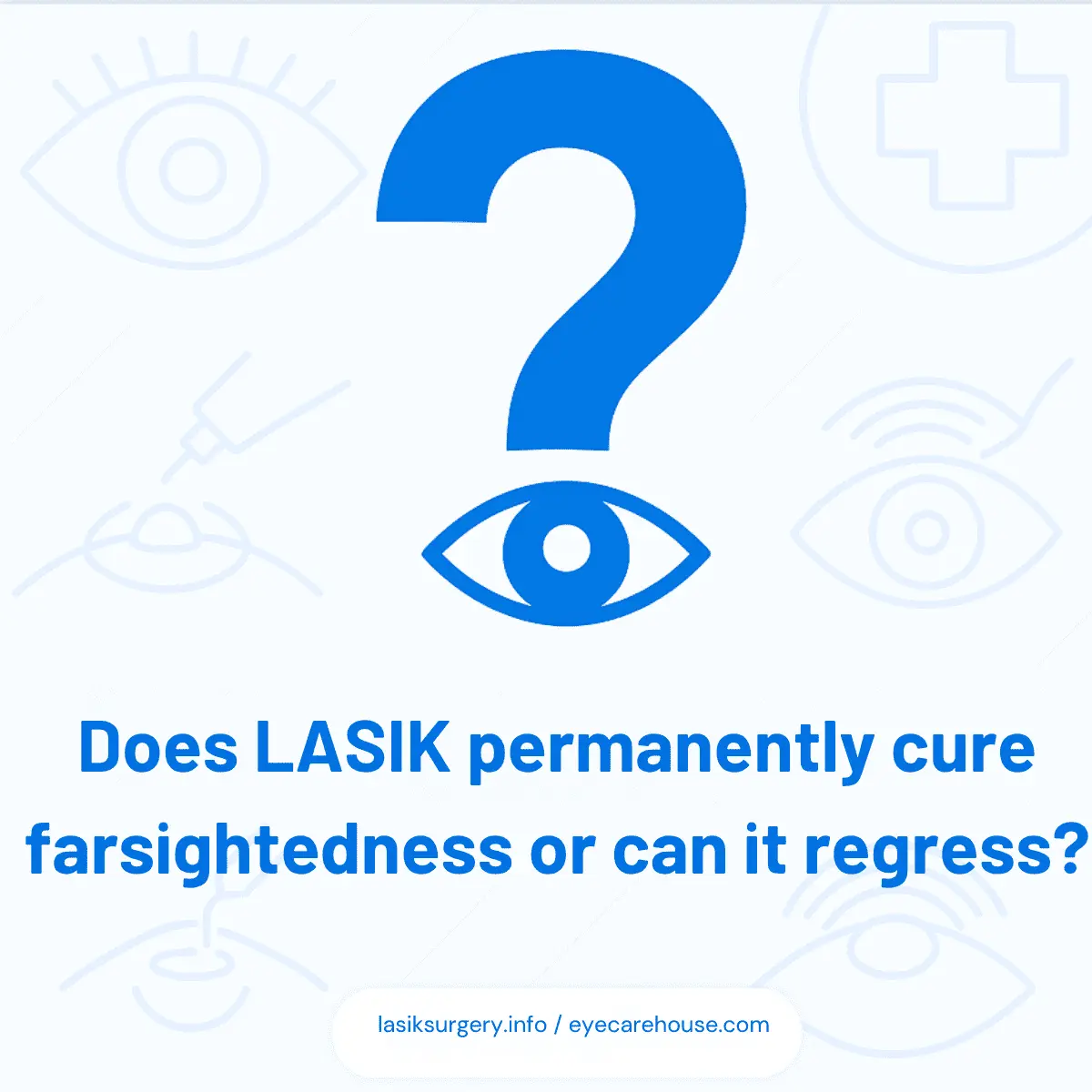
LASIK offers permanent correction and convenience, reducing or eliminating the need for daily lens care, discomfort, and cost of contacts.
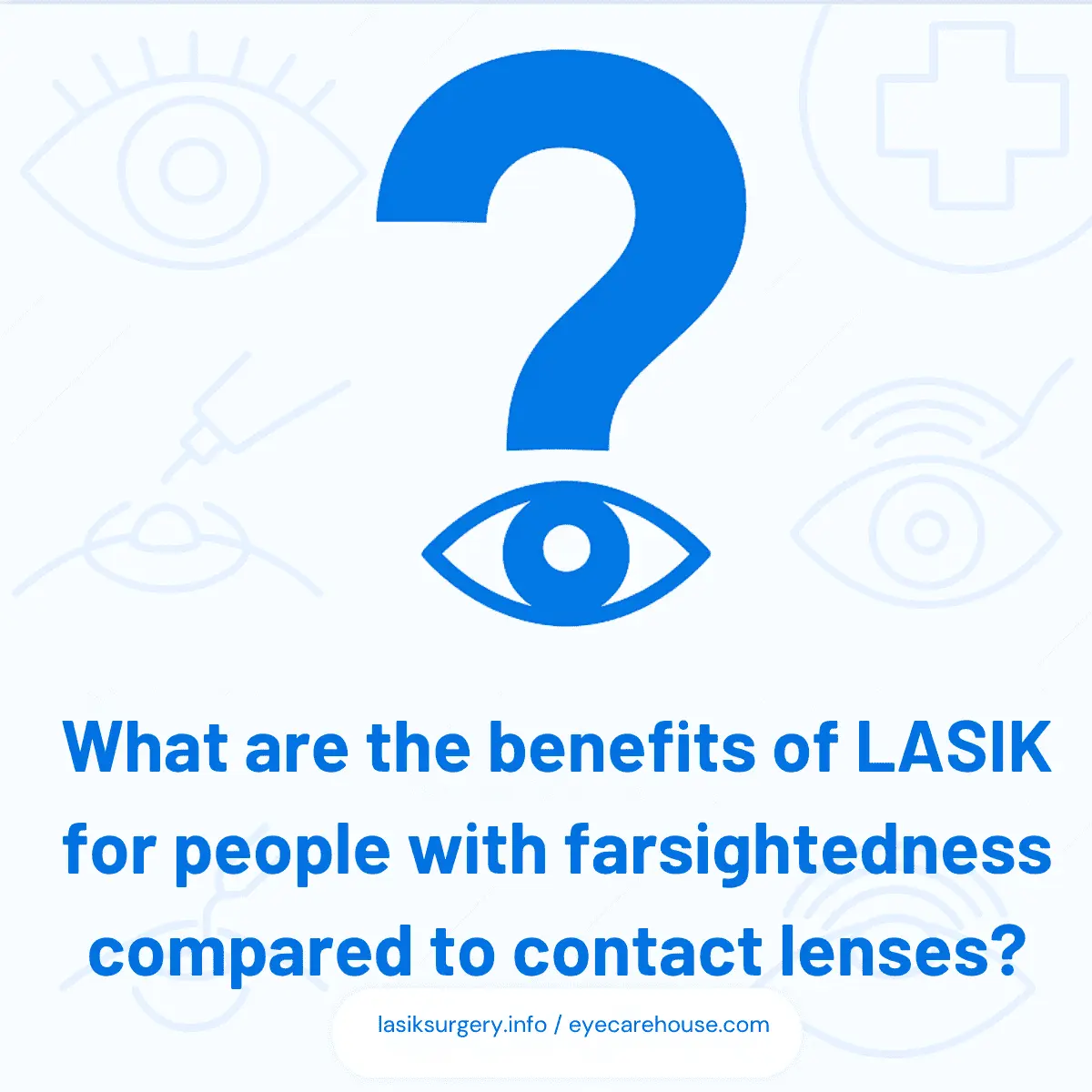
Sources
Mayo Clinic – Hyperopia Overview

